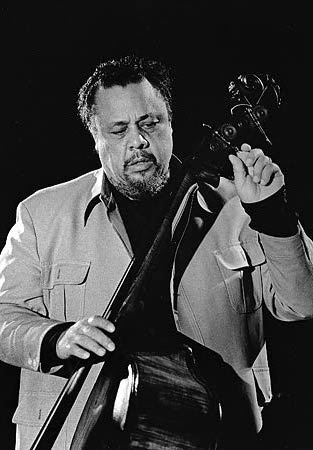104: Charles Mingus, ‘Myself When I Am Real’/’Adagio Ma Non Troppo’
Description
Charles Mingus, ‘Myself When I am Real’, from “Mingus Plays Piano”
Charles Mingus, ‘Adagio Ma Non Troppo’, from “Let My Children Hear Music”
 I came to jazz late in life, by a rather circuitous route. I’d been immersed in rock & roll since I was knee high to a grasshopper, and grew up with rock. I was 15 when ‘I Want To Hold Your Hand’ hit the radio, and lived within that music for the rest of the decade (quite literally, actually — I once saw a Grateful Dead concert from inside a loudspeaker; what’s that you say, Granny?).
I came to jazz late in life, by a rather circuitous route. I’d been immersed in rock & roll since I was knee high to a grasshopper, and grew up with rock. I was 15 when ‘I Want To Hold Your Hand’ hit the radio, and lived within that music for the rest of the decade (quite literally, actually — I once saw a Grateful Dead concert from inside a loudspeaker; what’s that you say, Granny?).
Thirty years later I went through a mid-life crisis. As always, I took care to DJ my life. I stopped listening to rock cold turkey, nourishing my bruised soul with the Bach solo keyboard oeuvre (see SoTW 5, Glenn Gould, Toccata in Cm) for two years non-stop, attempting to impose order on an otherwise chaotic world. Then I segued to the Preludes & Fugues of Dimitri Shostakovitch (see SoTW 84, Dmitri Shostakovich, Prelude & Fugue No 16 in B-flat Minor), an homage to Bach’s “Well-Tempered Clavier”. And then, somehow, I tripped over Charles Mingus’s “Let My Children Hear Music,” an orchestral album he made in 1972.
 To this day I associate Shostakovitch and Mingus in my mind. They’re both highly intellectual, willful, charismatic composers; often severe, harsh, brutally truthful; with not a little sweetness and romanticism in the mix. They’re both masters of melody who more often choose non-melodic, frequently atonal modes of expression. Often with both I find the accessible, the whistleable, bobbing and peeking through the dense forests of magnificent, grandiose, overwhelming angry constructs.
To this day I associate Shostakovitch and Mingus in my mind. They’re both highly intellectual, willful, charismatic composers; often severe, harsh, brutally truthful; with not a little sweetness and romanticism in the mix. They’re both masters of melody who more often choose non-melodic, frequently atonal modes of expression. Often with both I find the accessible, the whistleable, bobbing and peeking through the dense forests of magnificent, grandiose, overwhelming angry constructs.
So I started to learn jazz. I put nose to grindstone, downloaded a dozen lists of Essential Jazz Albums, sold my designer rock LP collection to a Dutch dealer and used the money to buy The 50 Greatest Jazz CDs. And no looking back.
I’d known an odd smattering of jazz beforehand–”Kind of Blue“, Vince Guaraldi’s “Cast Your Fate to the Wind” album, the inescapable Getz/Gilberto, even the original soundtrack of “Orpheu Negro”. But somehow I think of “Let My Children hear Music” as the first jazz album I encountered, fell in love with, and sort of understood on its own terms, going to it as A Jazz Album, meeting it there on its home ground and dealing with it as such.
 It’s a strange place to start jazz. It’s an orchestral album, more or less, rich arrangements ranging from a medium-sized combo to big band to full orchestra. It’s almost symphonic in conception, large-scale pieces running around ten minutes. The music is grandiose, inspired, inspiring, large-canvas.
It’s a strange place to start jazz. It’s an orchestral album, more or less, rich arrangements ranging from a medium-sized combo to big band to full orchestra. It’s almost symphonic in conception, large-scale pieces running around ten minutes. The music is grandiose, inspired, inspiring, large-canvas.
Charles Mingus (1922-1979) was a linebacker-sized bandleader, composer and bassist. He was brilliant and impossible and left a legacy of music employing an exceptionally wide range of styles, as accomplished as it is varied. Here’s the avant garde Charlie (with Eric Dolpy). Here’s the cuddly one (‘Self-Portrait in Three Colors from “Ah-Hum”). And here’s one of the first SoTWs I ever wrote, about his composition ‘Remember Rockefeller at Attica’, one of my very favorite Opening Cuts.
 He had a lot of fun with the names of his compositions. “Let My Children Hear Music” includes ‘The Shoes of the Fisherman’s Wife are Some Jazz Ass Slippers’; “Mingus Plays Piano” includes ‘Orange Was the Color of Her Dress, Then Silk Blues.’ Other notables include ‘All the Things You Could Be By Now if Sigmund Freud’s Wife was your Mother’, ‘If Charlie Parker Were a Gunslinger, There’d be a Whole Lot of Dead Copycats,’ and ‘Pithecanthropus Erectus’. He often gave the same composition different titles.
He had a lot of fun with the names of his compositions. “Let My Children Hear Music” includes ‘The Shoes of the Fisherman’s Wife are Some Jazz Ass Slippers’; “Mingus Plays Piano” includes ‘Orange Was the Color of Her Dress, Then Silk Blues.’ Other notables include ‘All the Things You Could Be By Now if Sigmund Freud’s Wife was your Mother’, ‘If Charlie Parker Were a Gunslinger, There’d be a Whole Lot of Dead Copycats,’ and ‘Pithecanthropus Erectus’. He often gave the same composition different titles.
On the one hand, he came into the studio with a very firm conception of what he wanted. On the other, he demanded the most creative skills from his musicians. Mingus was known to refuse to write out charts for his recording musicians, as was the practice of the time. He would teach them the fundamentals of the composition aurally, and then demand that they improvise the rest. He demanded involvement, total musical commitment. He once beat up one of his band members on stage, for not doing well enough during a performance.
 The origins of the compositions on “Let My Children Hear Music” are obscure. I just re-read the history of the album as described in the definitive autobiography “Mingus” by Brian Priestley, and it’s simply incomprehensible. And here are Charlie’s original liner notes, extensive, brilliant, also incomprehensible.
The origins of the compositions on “Let My Children Hear Music” are obscure. I just re-read the history of the album as described in the definitive autobiography “Mingus” by Brian Priestley, and it’s simply incomprehensible. And here are Charlie’s original liner notes, extensive, brilliant, also incomprehensible.
So let’s just stick to the few bare facts that are pretty clear and reliable here. From t





